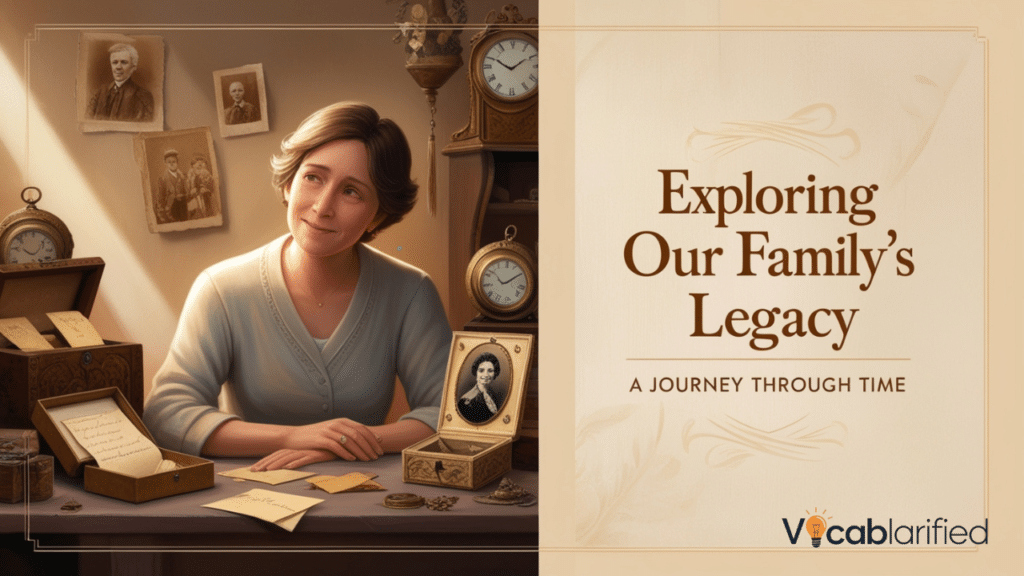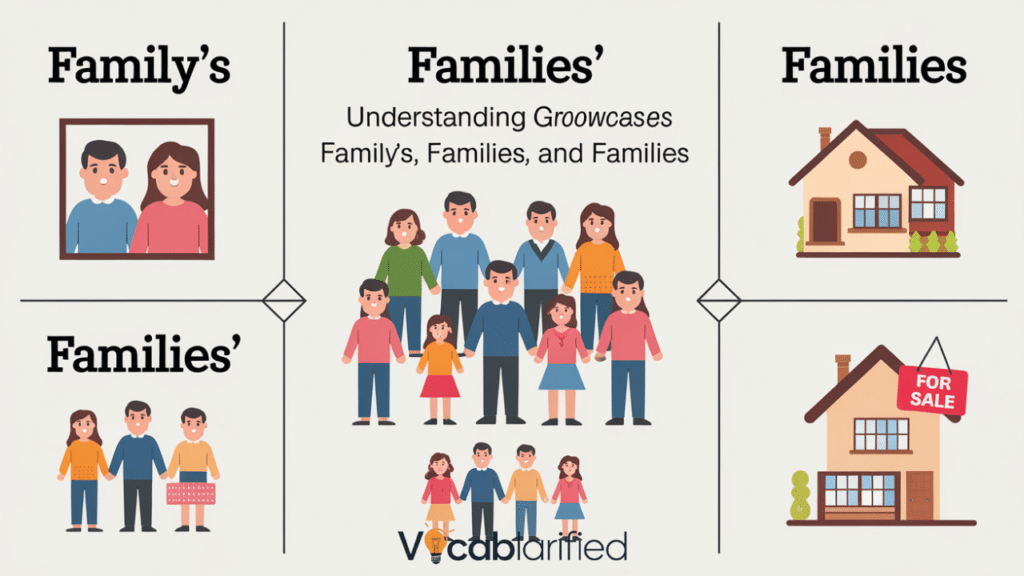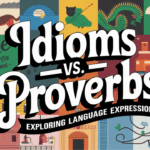English grammar can be a tricky landscape, especially when it comes to possessive and plural forms of words like “family.” Many writers find themselves puzzled by the subtle distinctions between family’s, families’, and families.
This comprehensive guide will unravel the mysteries of these linguistic variations, providing clear communication strategies that will elevate your writing precision.
The Fundamental Distinctions
Understanding the language nuances surrounding family-related terms requires a deep dive into their contextual usage. The words family’s, families’, and families might look similar, but they carry distinctly different meanings that can dramatically impact the message you’re trying to convey.
Singular Possessive: Family’s
The term family’s represents the possessive form of a single family. It indicates ownership or a characteristic belonging to one specific family unit. When you want to express something that belongs to or is associated with a single family, this is the form you’ll use.
Example Scenario: Consider an email from Sarah Thompson to her cousin Michael:
Subject: Family’s Annual Reunion Plan
Dear Michael,
I wanted to discuss our family’s traditional summer gathering this year. Our family’s reunion has always been a cherished event, and I’m hoping we can coordinate the details soon.
In this email, “family’s” clearly refers to the ownership and characteristics of one specific family group.
Usage Table for Family’s
| Context | Singular Possessive Example | Explanation |
|---|---|---|
| Personal Letter | Sarah’s family’s photo album | Refers to one family’s possession |
| Legal Document | The family’s inheritance rights | Indicates ownership by a single family |
| Insurance Form | Family’s medical history | Describing attributes of one family unit |
| School Registration | Family’s contact information | Singular family’s details |
| Real Estate | Family’s primary residence | Ownership by one family group |
| Holiday Card | Our family’s warmest wishes | Singular family’s collective greeting |
| Employment Record | Employee’s family’s background | One family’s related information |
| Medical Record | Patient’s family’s genetic history | Singular family’s medical context |
| Travel Booking | Family’s vacation preferences | One family’s travel choices |
| Property Deed | Family’s land ownership | Single family’s property rights |
You Might Like: Antithesis vs Juxtaposition | What’s the Difference?
Plural Possessive: Families’
Families’ represents the plural possessive form, indicating ownership or characteristics shared by multiple family groups. This form becomes crucial when discussing collective attributes or shared experiences of several families.
Example Scenario: A community center newsletter email:
Subject: Community Family Support Program
Dear Neighborhood Residents,
Our upcoming workshop will address the families’ shared challenges in modern urban living. Understanding families’ diverse needs helps us create more inclusive support systems.
Here, “families’” encompasses multiple family units and their collective experiences.
Usage Table for Families’
| Context | Plural Possessive Example | Explanation |
|---|---|---|
| Community Report | Families’ participation rates | Multiple families’ involvement |
| School Survey | Families’ educational preferences | Collective family group insights |
| Social Research | Families’ economic challenges | Plural families’ shared experiences |
| Healthcare Study | Families’ mental health trends | Multiple family units’ characteristics |
| Urban Planning | Families’ housing requirements | Collective family needs |
| Government Policy | Families’ welfare considerations | Multiple families’ shared concerns |
| Social Services | Families’ support program | Plural families’ collective assistance |
| Insurance Analysis | Families’ risk profiles | Multiple family units’ shared attributes |
| Educational Grant | Families’ income brackets | Collective family economic data |
| Migration Study | Families’ relocation patterns | Multiple families’ shared movements |
You Might Like: Vicious vs Viscous | Use Them Correctly in Writing
Simple Plural: Families
The term families represents the straightforward plural form, simply indicating more than one family without any possession implications. It’s the basic plural of “family” used when discussing multiple family units without emphasizing ownership.
Example Scenario: A local newspaper’s community section email:
Subject: Local Census Update
Dear Readers,
Our recent census reveals that families in our county are becoming more diverse. These families represent a rich tapestry of cultural backgrounds and life experiences.
In this context, “families” is a simple plural noun describing multiple family units.
Usage Table for Families
| Context | Simple Plural Example | Explanation |
|---|---|---|
| Demographics | Total number of families | Counting multiple family units |
| Social Report | Diverse families in region | Describing multiple family groups |
| Educational Survey | Families with school-age children | Plural family description |
| Housing Statistics | Average size of families | Measuring multiple family units |
| Community Event | Welcoming local families | Referring to multiple families |
| Health Research | Families participating in study | Plural family involvement |
| Cultural Program | Supporting immigrant families | Multiple family groups |
| Economic Analysis | Income distribution among families | Examining plural family units |
| Social Services | Resources for different families | Multiple family unit support |
| Community Planning | Needs of various families | Addressing plural family diversity |
You Might Like: Ninety or Ninty | Which Is the Correct Spelling?
Mastering the Distinctions
Mistake avoidance in English grammar requires understanding these subtle yet significant differences. By recognizing when to use family’s, families’, or families, you elevate your writing clarity and ensure precise communication.
Navigating Family Grammar Mysteries
English grammar can be a tricky landscape, especially when it comes to possessive and plural forms of words like “family.” Many writers find themselves puzzled by the subtle distinctions between family’s, families’, and families. This comprehensive guide will unravel the mysteries of these linguistic variations, providing clear communication strategies that will elevate your writing precision.
The Linguistic Landscape of Family Terms
The world of language nuances is particularly complex when it comes to words that represent collective groups. The terms family’s, families’, and families might appear similar at first glance, but they carry profound differences that can dramatically impact the meaning of your written or spoken communication.
Deep Dive into Grammatical Foundations
Understanding these terms requires more than a surface-level examination. Each variation represents a unique grammatical construct that speaks to the contextual usage of language. Whether you’re drafting a formal document, writing a personal email, or creating academic content, mastering these distinctions is crucial for contract precision and writing clarity.
The Singular Possessive: Exploring Family’s
The term family’s represents the possessive form of a single family unit. It’s a powerful linguistic tool that indicates ownership or a characteristic belonging to one specific family group. This form becomes particularly important when you want to attribute something specifically to one family’s experiences, possessions, or characteristics.
Example Scenario: A heartfelt letter between siblings:
Subject: Our Family’s Legacy
Dear Emma,
I’ve been reflecting on our family’s remarkable history. Our family’s journey through generations has always been a source of inspiration for me. The stories passed down through our family’s lineage are truly extraordinary.
In this intimate communication, “family’s” creates a sense of unity and shared identity, highlighting the unique characteristics of one specific family unit.
Comprehensive Usage Table for Family’s
| Professional Context | Personal Context | Emotional Significance |
|---|---|---|
| Legal document describing inheritance | Family photo album annotation | Connecting to familial roots |
| Insurance form detailing medical history | Personal memoir writing | Expressing family identity |
| School registration paperwork | Holiday greeting card | Celebrating family uniqueness |
| Employment background check | Family tree documentation | Preserving family narrative |
| Real estate ownership record | Genealogy research | Honoring family heritage |
| Corporate emergency contact form | Personal journal entry | Exploring family dynamics |
| Medical record documentation | Family recipe collection | Maintaining family traditions |
| Travel insurance application | Family heirloom description | Connecting generations |
| Property deed registration | Family history manuscript | Documenting family journey |
| Academic recommendation letter | Personal storytelling | Preserving family memory |
Grammatical Complexity and Nuanced Meanings
Language learning involves understanding more than just rules; it’s about grasping the subtle language nuances that give depth to communication. The difference between family’s, families’, and families might seem minor, but in formal writing and everyday communication, these distinctions can dramatically alter meaning.
The Plural Possessive: Unveiling Families’
Families’ represents the plural possessive form, a more complex grammatical construct that indicates ownership or shared characteristics among multiple family groups. This form becomes essential when discussing collective experiences, shared challenges, or community-wide phenomena.
Example Scenario: A community center’s outreach communication:
Subject: Supporting Neighborhood Families
Dear Community Members,
Our recent research highlights the critical importance of understanding families’ diverse needs. The families’ collective experiences provide invaluable insights into our community’s strengths and challenges.
The use of “families’” here emphasizes the shared experiences and collective identity of multiple family units.
Comprehensive Usage Table for Families’
| Sociological Context | Research Perspective | Community Impact |
|---|---|---|
| Community welfare report | Demographic studies | Understanding social dynamics |
| Educational policy analysis | Socioeconomic research | Identifying collective challenges |
| Healthcare accessibility study | Migration pattern investigation | Recognizing community needs |
| Urban planning document | Cultural integration research | Supporting diverse populations |
| Social services assessment | Economic trend analysis | Addressing systemic challenges |
| Government policy proposal | Educational opportunity study | Promoting inclusive strategies |
| Mental health resources report | Generational change research | Enhancing community support |
| Housing development plan | Societal transformation analysis | Adapting to changing family structures |
| Cultural diversity initiative | Comparative family structure study | Celebrating community complexity |
| Community resilience report | Social network investigation | Fostering community connections |
The Simple Plural: Understanding Families
The term families represents the straightforward plural form, simply indicating more than one family without any possession implications. It’s the fundamental plural of “family” used when discussing multiple family units in a neutral, descriptive manner.
Example Scenario: A local government census report:
Subject: Community Demographics Update
Dear Residents,
Our latest census reveals fascinating insights. Families in our region represent an increasingly diverse demographic. These families showcase the rich cultural tapestry of our community.
Here, “families” serves as a neutral descriptor of multiple family units, highlighting their collective presence without emphasizing ownership.

Comprehensive Usage Table for Families
| Statistical Context | Social Perspective | Descriptive Application |
|---|---|---|
| Population census data | Community diversity report | Representing multiple households |
| Demographic analysis | Social inclusion study | Describing population segments |
| Educational enrollment statistics | Cultural integration research | Capturing societal composition |
| Economic impact assessment | Social mobility investigation | Understanding community structure |
| Healthcare accessibility report | Generational change analysis | Exploring social dynamics |
| Housing market research | Migration pattern study | Tracking population movements |
| Social services planning | Ethnic diversity investigation | Recognizing community complexity |
| Government policy development | Social network research | Mapping community interactions |
| Urban development strategy | Sociological transformation study | Understanding social evolution |
| Public health planning | Cultural adaptation research | Exploring community resilience |
Mastering Grammar’s Subtle Art
Mistake avoidance in English grammar is not about rigid rules but understanding the subtle contexts that give language its richness. By recognizing the nuanced differences between family’s, families’, and families, you elevate your writing clarity and ensure precise communication.
Grammar tips for mastering these distinctions include:
- Always consider the specific context
- Read your sentence aloud to check for clarity
- When in doubt, rephrase to avoid ambiguity
- Practice writing scenarios that demonstrate each form
- Seek feedback from language experts or writing groups
Embracing these language nuances transforms writing from mere communication to an art form of clear communication.

Emma Carter is an experienced blogger at Vocablarified. She enjoys helping people expand their vocabulary and improve their language skills. With a warm and approachable writing style, Emma makes learning new words fun and accessible. When she’s not writing, she loves reading books and discovering new phrases to share with her readers. Emma is passionate about making language learning an enjoyable journey for everyone.







